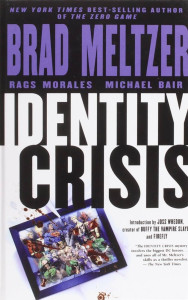 Every year on my dad’s birthday, I include in his gift a complete comic mini-series, in graphic novel form, of some old favourite of his from either the DC or Marvel universes. Like me (and most men who were once boys), he has a permanent appreciation for the comic art form: a certain un-tarnished fondness for particular characters, which will endure through numberless revisits and re-imaginings. He and I are not hard-core comic aficionados; neither of us spends enough time in comic stores to keep up with a series that may take years to complete, one monthly issue at a time. So I’m a fan of these collections, even if I don’t read more than one or two in a given year, because I might not otherwise read any comics at all.
Every year on my dad’s birthday, I include in his gift a complete comic mini-series, in graphic novel form, of some old favourite of his from either the DC or Marvel universes. Like me (and most men who were once boys), he has a permanent appreciation for the comic art form: a certain un-tarnished fondness for particular characters, which will endure through numberless revisits and re-imaginings. He and I are not hard-core comic aficionados; neither of us spends enough time in comic stores to keep up with a series that may take years to complete, one monthly issue at a time. So I’m a fan of these collections, even if I don’t read more than one or two in a given year, because I might not otherwise read any comics at all.
Identity Crisis is a limited series focussed on the Justice League of America, one of the better known DC superhero collaborations. It’s different from, say, the Avengers, in that the members of the JLA mostly have had their own individual series previous to (and often concurrent with) the various JLA series. Members have included Superman, Batman, Wonder Woman, and the Flash, along with lesser-known characters such as Atom and the Elongated Man. In telling this story, Meltzer focused primarily on some of these lesser-known characters, while employing the iconography of the big guys and the decades long history of the League itself to add weight to the story.
There’s a lot of history here: the JLA is a Silver Age comic book creation, while most of its core members are themselves Golden Age heroes. There’s a definite sense that Meltzer pokes subtly at the fourth wall — some of the newer and less prominent members of the team seem to speak for the audience in holding the League history, and the old battles of timeless heroes like the original Flash, Green Lantern, or Batman, on a kind of pedestal. They aren’t just talking about the universe of the story itself, they’re talking about our perception, as fans, of how and why these guys became legends. Why, no matter how old we get, we’ll never outgrow Superman, even if we think we’ve outgrown comic books.
The revelations in Identity Crisis make us look back to the very beginning of the JLA, to stories decades old, and see those classic stories in a completely different, darker, but non-contradictory way. Stories from the canon that may have been too constricted by the comic code to take such a tone at the time nevertheless held some messy implications that Meltzer explores. He begins by showing us the dark side of a convention that we usually take for granted: the mask. We all know that heroes wear costumes and masks so that their families aren’t at risk from their many enemies. We accept that explanation for brightly coloured spandex and don’t give it another thought. In Identity Crisis, the story opens on the unthinkable: a horrifying murder occurs because somebody knew who was behind the mask, saw a weakness, and acted on it.
The emotion throughout the series is raw and poignant, and penciler Rags Morales deserves a lot of credit for bringing the art to life. As stories in comics have become more adult, so the art has followed suit, and Morales is of the modern school. I appreciate the insight into both writing and drawing processes in creating this series included in the behind-the-scenes section at the end of the book. (Michael Bair is the penciler.)
This is a story that couldn’t have been told 30 years ago, but without the stories that were told 30 years ago, it would have nothing to stand on today. Thoroughly modern and thoroughly faithful to the origins and history of the JLA even while reinventing it, Identity Crisis is, simultaneously, a departure point to brave new territories for the eager, regular readers; and a faithful adult revisiting for grown-ups who haven’t been to the comic shop for a few years.
(DC Comics, 2005)
